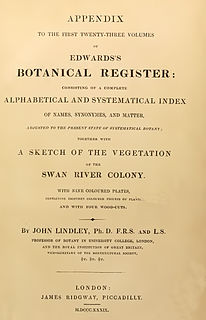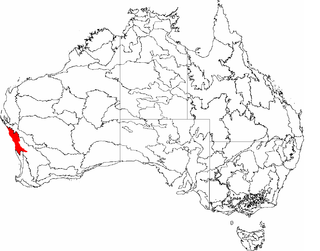
Pterostylis coccina, commonly known as the scarlet greenhood, is a species of orchid endemic to eastern Australia. As with similar greenhoods, the flowering plants differ from those which are not flowering. The non-flowering plants have a rosette of leaves flat on the ground but the flowering plants have a single flower with leaves on the flowering spike. In this species, the rosette leaves are relatively large and dark green, and the flowers are white, and bluish-green or red. It grows in New South Wales and north-eastern Victoria.

Pterostylis barbata, commonly known as the western bearded greenhood or bird orchid is a species of orchid endemic to the south-west of Western Australia. Flowering plants have a rosette of leaves at the base of the plant and a single translucent white flower with dark green veins on a flowering stem with up to 20 stem leaves. It is one of a number of bearded orchids, some of which have yet to be formally described, all of which have a distinctive feather-like labellum.

Pterostylis atrans, commonly known as the dark-tip greenhood or blunt-tongue greenhood, is a species of orchid endemic to south-eastern Australia. As with similar greenhoods, plants in flower differ from those that are not flowering. The non-flowering plants have a rosette of leaves flat on the ground, but the plants in flower have a single flower with leaves on the flowering spike. In this species, the flower is green and reddish brown with a protruding sinus and small club-like tips on the ends of the lateral sepals.

Pterostylis decurva, commonly known as the summer greenhood, is a species of orchid endemic to south-eastern Australia. As with similar greenhoods, the flowering plants differ from those which are not flowering. The non-flowering plants have a rosette of leaves but the flowering plants have a single flower with leaves on the flowering spike. This greenhood usually flowers in summer and has a white flower with green stripes and a brownish tinge. It is similar to P. aestiva but has paler green flowers.

Pterostylis dolichochila, commonly known as the long-tongued shell orchid, is a species of orchid endemic to southern Australia. As with similar orchids, the flowering plants differ from those which are not flowering. The non-flowering plants have a rosette of leaves but the flowering plants have a single flower with leaves on the flowering spike. This greenhood has a green and white flower with reddish-brown stripes and a sharply pointed dorsal sepal.
Pterostylis furcata, commonly known as the forked greenhood, is a species of orchid endemic to Tasmania. Flowering plants have a rosette of bright green leaves at the base of the flowering stem and a single green and white flower with the tip of the dorsal sepal pointing above the horizontal.

Pterostylis hamiltonii, commonly known as the red-veined shell orchid, is a species of orchid endemic to the south-west of Western Australia. As with similar orchids, the flowering plants differ from those which are not flowering. The non-flowering plants have a rosette of leaves but the flowering plants lack a rosette and have a single flower with leaves on the flowering spike. This greenhood has a green and white, striped flower with reddish-brown markings and forms colonies, sometimes of thousands of plants.

Pterostylis scabrida, commonly known as the rough greenhood, is a species of orchid endemic to Tasmania. It has a rosette of leaves at the base of the plant and a single green and white flower on a rough stem. It is widespread and common in wet forests and is one of the few species of Pterostylis to grow in rainforest.
Pterostylis angusta, commonly known as the narrow shell orchid, is a species of orchid endemic to the south-west of Western Australia. As with similar greenhoods, the flowering plants differ from those which are not flowering. The non-flowering plants have a rosette of leaves flat on the ground but the flowering plants have a single flower with leaves on the flowering spike. In this species the flower is green, white and brown with an inflated base, a narrow hood and the longest labellum of any Western Australian Pterostylis species.
Pterostylis aphylla, commonly known as the leafless greenhood, is a species of orchid endemic to Tasmania. As with similar greenhoods, the flowering plants differ from those which are not flowering. The non-flowering plants have a rosette of leaves flat on the ground but in this species, the flowering plants have a single green and white flower with a brown tip and lack leaves apart from a few small scales.

Pterostylis sp. aff. alata is a species of orchid endemic to New South Wales but which has not yet been formally described. Non-flowering plants have a rosette of leaves but the flowering plants have a single flower with leaves on the flowering spike. This greenhood has a white flower with green markings and a brown-tipped dorsal sepal. It is only known from areas near Armidale where it grows near south-facing escarpments.
Pterostylis erythroconcha, commonly known as the red shell orchid, is a species of orchid endemic to South Australia. As with similar orchids, the flowering plants differ from those which are not flowering. The non-flowering plants have a rosette of leaves but the flowering plants have a single flower with leaves on the flowering spike. This greenhood has a white and green flower with reddish brown markings and a long, fleshy, curved labellum.

Pterostylis longicurva, commonly known as the long-tongued greenhood, is a species of orchid endemic to eastern Australia. As with similar greenhoods, plants in flower differ from those that are not. Those not in flower have a rosette of leaves lying flat on the ground, but plants in flower have a single flower with leaves on the flowering stem. This species has a white and green flower with brown markings and a long, curved, brown labellum.
Pterostylis mitchellii, commonly known as Mitchell's rustyhood, is a plant in the orchid family Orchidaceae and is endemic to eastern Australia. Both flowering and non-flowering plants have a rosette of leaves and flowering plants have up to fifteen flowers which have wide flanges on the petals and an insect-like labellum with a white "head".
Pterostylis parva, commonly known as the fawn snail orchid, is a species of orchid endemic to the south-west of Western Australia. As with similar greenhoods, the flowering plants differ from those which are not flowering. The non-flowering plants have a small rosette of leaves flat on the ground but the flowering plants have a single flower with leaves on the flowering spike. In this species, the flower is small, fawn, green and white and is similar to P. timothyi but smaller in stature.
Pterostylis rogersii, commonly known as the curled-tongue shell orchid, is a species of orchid endemic to the south-west of Western Australia. As with similar orchids, the flowering plants differ from those which are not flowering. The non-flowering plants have a rosette of leaves but the flowering plants lack a rosette and have a single flower with leaves on the flowering spike. This greenhood usually has a white and reddish-brown striped flower with a long, curved labellum and is found along the south coast between Binningup and Esperance.
Pterostylis timothyi, commonly known as the brittle snail orchid or fawn snail orchid is a species of orchid which is endemic to the south-west of Western Australia. It has a rosette of leaves at its base, and when flowering, a single green, fawn and white with erect lateral sepals.
Pterostylis brunneola, commonly known as the giant snail orchid, is a species of orchid endemic to the south-west of Western Australia. Both flowering and non-flowering plants have a large rosette of leaves flat on the ground and flowering plants have a single distinctive white flower with pale fawn stripes and have leaves on the flowering spike. This species often forms large colonies, sometimes with Caladenia species.
Pterostylis erubescens, commonly known as the red sepaled snail orchid, is a species of orchid endemic to the south-west of Western Australia. Non-flowering plants have a rosette of leaves flat on the ground but flowering plants lack a rosette and have a single large green flower which turns reddish-brown as it ages, and has leaves on the flowering spike.
Pterostylis microglossa, commonly known as the Kalbarri shell orchid, is a species of orchid endemic to the south-west of Western Australia. Non-flowering plants have a rosette of leaves flat on the ground but flowering plants lack a rosette and have a flowering stem with leaves and a single green, white and brownish-red flower.





















